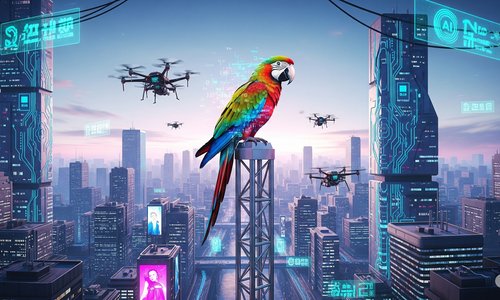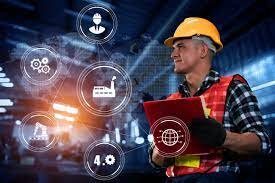
A Promessa e o Perigo da Nova Revolução Digital
A nova corrida tecnológica global levanta uma pergunta urgente: estamos prontos para confiar na inteligência que criamos?

Na percepção de técnicos da Siemens, a indústria 4.0, “... Também chamada de Quarta Revolução Industrial, é um conceito, apresentado ao público pela primeira vez na Feira de Hannover de 2011, que representa a automação industrial e a integração de soluções tecnológicas inovadoras, como inteligência artificial, internet das coisas, robótica e utilização de dados em nuvem. Na ocasião de sua denominação, empresas de tecnologia, universidades e centros de pesquisa apoiados pelo governo da Alemanha propuseram uma nova visão para a operação das fábricas: um modelo com descentralização do controle dos processos produtivos e colaboração entre dispositivos inteligentes. Tudo isso interconectado ao longo de toda a cadeia de produção e logística, transformando a maneira como as máquinas se comunicam e utilizam as informações para otimizar a produção (1)”.
Hoje em dia, 2022, tecnologias como Blockchain, Realidade Aumentada, Realidade Virtual, Metaverso, Big Data e Analytics, Impressão 3D etc. são destaques no âmbito da Indústria 4.0, juntando-se à Inteligência Artificial nas suas diversas modalidades, à Internet das Coisas etc.
Relevância de mesma ordem tem também as questões relativas à infraestrutura digital: a computação em nuvens híbridas e as questões de cyber-segurança no sentido mais amplo possível.
Inovação Tecnológica nos Negócios
A figura (2) abaixo mostra a utilização integrada das tecnologias digitais, propiciando a inovação nos negócios, inclusive em âmbito industrial. Sensores, redes digitais e analógicas, plataformas e devices de Internet das Coisas, aplicações e bases de dados, ecossistemas integrados por Blockchain, uso de Inteligência Artificial via visão computacional, machine learning etc. são tecnologias que se integram em função da inovação do negócio.
O Fórum Econômico Mundial
Segundo os especialistas do Fórum Econômico Mundial, “A Quarta Revolução Industrial representa uma mudança fundamental na forma como vivemos e trabalhamos. É um novo capítulo no desenvolvimento humano, possibilitado por avanços que são proporcionais aos da primeira, segunda e terceira revoluções industriais - fundindo os mundos físico, digital e biológico e fundindo tecnologias de maneira que criam tanto promessas quanto perigos. A velocidade, amplitude e profundidade dessa revolução nos forçou a repensar como os países devem se desenvolver, como as organizações criam valor e como pessoas de todas as esferas da vida podem se beneficiar da inovação. Agora, enquanto o mundo lida com o COVID-19, há uma oportunidade de abraçar ainda mais essa revolução de maneiras que criem uma economia global mais inclusiva e centrada no ser humano” (3).
A complexidade resultante do uso integrado das tecnologias Blockchain, Internet das Coisas e Inteligência Artificial
A construção de ecossistemas integrados por arquitetura Blockchain pode se tornar razoavelmente complexa se considerarmos os subsistemas de captação de dados via ferramentas de IoT, como no caso da produção industrial em que processos dependem de materiais mantidos em temperaturas controladas (caso da produção dos derivados do leite, por exemplo). Sensores detectam temperaturas fora dos limites adequados e enviam alarme ao sistema. Atuadores, após análise da situação por “smart contracts”, desviam o lote de produção fora dos parâmetros autorizados para o recipiente de materiais a serem analisados e eventualmente descartados. Os registros relativos às ocorrências permanecerão, de modo confiável e rastreável, em ambiente Blockchain para futuras análises.
A complexidade pode crescer ainda mais se as informações a serem registradas pelo Blockchain acontecerem em decorrência de decisões tomadas com o uso de ferramentas de Inteligência Artificial.
Observe-se que tanto o tema da visão computacional quanto do aprendizado das máquinas ou mesmo o processamento de linguagem natural, temas relevantes em IA, precisam ter sua lógica explicada, de forma clara e transparente, o que nem sempre ocorre, principalmente se usarmos redes neurais em aprendizado profundo.
Sobre a questão da explicabilidade no caso de uso de ferramentas de Inteligência Artificial em ecossistemas integrados por Blockchain.
“Explainable artificial intelligence (XAI)” é um conjunto de processos e métodos que permite que usuários humanos compreendam e confiem nos resultados e saídas criados por algoritmos de aprendizado de máquina.
A explicabilidade de Inteligência Artificial (XAI) é usada para descrever um modelo de IA, seu impacto esperado e possíveis vieses. Ele ajuda a caracterizar a precisão, a imparcialidade, a transparência e os resultados do modelo na tomada de decisões com inteligência artificial. A IA explicável é crucial para uma organização construir confiança ao colocar modelos de IA em produção. A explicabilidade da IA também ajuda uma organização a adotar uma abordagem responsável para o desenvolvimento da IA. À medida que a IA se torna mais avançada, os humanos são desafiados a compreender e refazer como o algoritmo chegou a um resultado. Todo o processo de cálculo é transformado no que é comumente chamado de "caixa preta" que é impossível de interpretar. Esses modelos de caixa preta são criados diretamente a partir dos dados. E nem mesmo os engenheiros ou cientistas de dados que criam o algoritmo podem entender ou explicar o que exatamente está acontecendo dentro deles ou como o algoritmo de IA chegou a um resultado específico.” (4).
O uso integrado de ferramentas de IA em conjunto com o tratamento de dados oriundos de devices de IoT, sendo processados em um ecossistema com vários participantes, de diversas categorias e de diferentes organizações (integrados via Blockchain) pode propiciar um benefício essencial à questão da explicabilidade em IA (XAI).
Em resumo, poder-se-á registrar no Blockchain o conjunto dos parâmetros e dos dados auditados em relação ao algorítmo que tomou a decisão.
Suponhamos, por exemplo uma decisão de retirada de um operador de uma linha de montagem industrial em consequencia da tomada de decisão de um algorítmo que considerou temerárias as práticas do trabalhador em questão. Afastado de suas funções, o trabalhador poderá questionar a gestão da empresa a respeito das razões para a tomada de decisão que o retirou da operação da fábrica. Utilizando o susbistema de Explicabilidade de IA (XAI), efetua-se o registro no ambiente Blockchain. Assim, será possível rastrear a decisão tomada por IA, com garantia da veracidade da informação.
Ante Mesin (5) lembra que a arquitetura Blockchain, também conhecida como “Distributed Ledger Technology (DLT)” e a inteligência artificial (AI), quando utilizadas em conjunto, permitem que as máquinas executem tarefas inteligentes enquanto a tecnologia blockchain registra e armazena dados e eventos cronologicamente. Sabemos que o blockchain faz os registros dos dados nele depositados de maneira imutável e rastreável, possibilitando ainda a integração de susbsistemas fechados dentro de suas organizações e abertos em relação aos dados relevantes às transações do ecossistema. É o caso da Renault que, utilizando o blockchain, integra participantes de diferentes categorias (fornecedores de peças, equipes de certificação, prestadores de serviços de manutenção industrial, clientes etc.) em ambiente no qual os dados necessários ao funcionamento do ecossistema são compartilhados mas os dados internos de cada uma das categorias de participantes são protegidos (6).
Cabe aos arquitetos de um sistema com estas características o design do projeto, incluindo a questão da explicabilidade à luz da ética que rege o negócio em que se inserem as tecnologias ora mencionadas.
Referências:
e-mail: antonio.limongi@hx8.com.br
http://lattes.cnpq.br/9469008438285343
www.linkedin.com/in/antonio-limongi
Consultor – Empresa LF1 Inovação
Parceiro de Negócios - IBM/INGRAM
Co-Criador da Criptomoeda ECOCHAIN Moeda Verde
Pesquisador e Professor - Grupos “Smart Cities” – Departamento de Engenharia de Produção – PRO/Poli/USP/F. Vanzolini e Gestão do Conhecimento/Redes de Cooperação – PRO/Poli/USP
Pós-doutor - Departamento de Engenharia de Produção–Poli/USP – Blockchain e Negócios de impacto social
Doutor em Inovação e em Estratégias Organizacionais - UNINOVE
Mestre em Direito Econômico – Mackenzie
MBA - Branding - FIRP/BRUNEL (UK)
Graduado em Direito (USP)
Graduado em Administração (S. Leopoldo, Santos)
Associado da I2AI, Grupo Inovação e IA
Membro da LACLIMA, Rede de Advogados pelo Clima
Membro da APROCORTE, Assoc. Produtores de Gado de Corte

A nova corrida tecnológica global levanta uma pergunta urgente: estamos prontos para confiar na inteligência que criamos?

Por que dominar a IA será a nova alfabetização do século XXI

Conselhos de Administração devem evoluir da supervisão reativa para a antecipação estratégica, frente à crescente complexidade e volatilidade dos ambientes de negócios.

De 14 a 25 de julho, reserve suas manhãs das 08h00 às 09h30 para participar da tradicional Maratona I2AI! Uma jornada intensa com debates e palestras sobre temas essenciais: Ética,